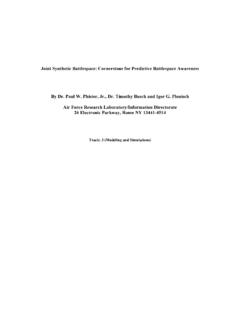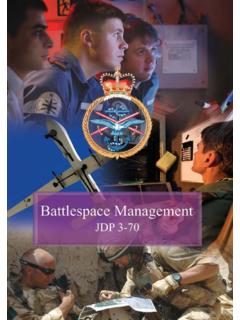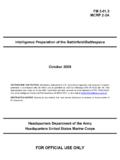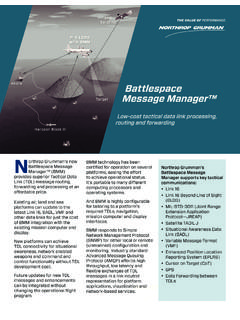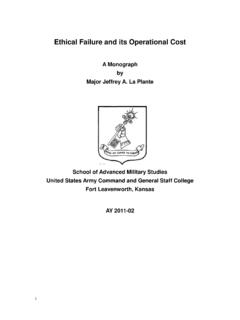Transcription of Applying Geospatial Information and Services Capabilities ...
1 DOI: 2016, IGI Global. Copying or distributing in print or electronic forms without written permission of IGI Global is Journal of Applied Geospatial ResearchVolume 7 Issue 4 October-December 2016 Applying Geospatial Information and Services Capabilities Beyond the BattlespaceBrian J. Cullis, United States Air Force (Retired), Colorado Springs, CO, USAD avid F. LaBranche, Defense Installations Spatial Data Infrastructure (DISDI) Program, Alexandria, VA, USAABSTRACTW hile Geospatial Information resources have traditionally imparted situational awareness in the battlespace , the past twenty years has witnessed broad adoption in other defense environments as well.
2 This paper describes the major catalysts spurring broader investment and use of Geospatial Information and Services (GI&S) beyond the battlespace and into a parallel defense installation mission area known as basingspace. Furthermore, the paper details how the benefits of GI&S for delivering shared situational awareness in both battlespace and basingspace has the National Guard poised to exploit Geospatial technologies in a more strategic manner. This paper presents a concise history of how social and technical factors influenced the diffusion of applied Geospatial technologies within the defense sector and the potential for greater unity of Geospatial efforts for the Department of Defense and the , Common Operational Picture, Geospatial Information and Services , GIS Adoption, GIS Diffusion, Installation, Shared Situational Awareness, Situational AwarenessINTRodUCTIoNToday s battlespace is a dynamic environment where enemy and friendly forces interact, and the victor often must dominate both the physical and cyber or Information domains.
3 Military planners from Sun Tzu to the present have always viewed knowledge of the terrain as vital for operational planning, albeit remarkable Information technologies to include remote sensing and geographic Information and Services (GI&S) now empower warfighters with situational awareness (SA).The rapid diffusion of GI&S Capabilities over the past twenty years beyond the battlespace has led to recognition of a parallel environment of basingspace where military forces have found knowledge of the built and natural infrastructures and the resulting SA to be vital for the defense mission. Today s military base or installation is the foundation of all successful national defense operations, including homeland defense.
4 Each military service depends upon their installations to project power into the battlespace as well as to serve as force regeneration platforms. The base is also a military city in that they share many traits of a municipality to include infrastructure, schools and housing, as well as a need to interact with surrounding communities and governmental Journal of Applied Geospatial ResearchVolume 7 Issue 4 October-December 201665 Geospatial Information and Services (GI&S) refers to the array of technologies, databases, personnel, web Services and Information resources essential for acquiring and conveying situational awareness. Just as warfighters pursue operational dominance with the aid of a common operational picture or COP, the protection, operation and sustainment of today s military base or installation also now requires an equivalent common installation picture or CIP to ensure unity of effort.
5 Furthermore, GI&S technologies have proved invaluable for gaining shared situational awareness to support domestic operations in the wake of natural and man-made disasters within our national boundaries (Westlund, 2010).Whether the environment is the military battlespace , the military basingspace or the complex civil-military domestic operations arena, all share a need for situational awareness The advent of Net-Centric Warfare (NCW) introduced a new focal point to better convey the benefits of sharing GI&S in pursuit of shared situational awareness or SSA (Alberts, 2002; Nofi, 2000). NCW tenets logically associate a networked force with facilitating Information sharing and collaboration, which, in turn, enhances shared SA, enabling self-synchronization and ultimately improved mission effectiveness.
6 In short, NCW tenets offered a technology-agnostic paradigm of an effects-based outcome to pursuing GI&S for shared SA across all paper describes how the benefits of GI&S have diffused beyond the battlespace to be an integral part of the Department of Defense (DoD) basing mission and is poised for adoption by the National Guard to contribute to domestic operations. Hindsight reveals GI&S adoption in the DoD has been an inherently socio-technological process, while foresight portends an emerging GI&S paradigm of a more encompassing definition of Geospatial intelligence to benefit the broader defense advertised merits of Geospatial Information resources encouraged widespread investments in GI&S in the early 1990s from local governments to federal agencies, where all envisioned cost-effective sharing of Geospatial Information to serve countless purposes.
7 Ironically, GI&S adoption researchers found bureaucratic attributes such as functional specialization and a lack of cross-functional processes severely limited the ability of GI&S investors to achieve their desired goals (Cullis, 1995; Omran, Bregt, & Crompvoets, 2009).In 2001, the USAF Civil Engineer launched the USAF GeoBase program in response to the discovery of very costly, redundant acquisitions of GIS technology by multiple organizations within their installations. All too frequently, these organizations acquired the commercial GIS solution before understanding either the mission requirements or designing an effective path to organizational adoption.
8 Furthermore, the lack of any focal point to facilitate the sharing of Geospatial Information on the installation enabled disjointed, incompatible and redundant GIS two years, the USAF GeoBase program had secured the shared SA envisioned by NCW advocates within the varied cultures of twelve Major Commands, Field Operating Agencies and Direct Reporting Units. The GeoBase program achieved this unity of Geospatial efforts by first establishing an empowered focal point for GeoBase activities on the Air Staff within the Civil Engineer Directorate and by establishing close ties with the new Air Force Chief Information Officer (CIO). The GeoBase program blazed a new cultural path by emphasizing the holistic, synergistic nature of GI&S as a portfolio of Geospatial Information resources, to include, but not limited to, software, hardware, personnel, data and imagery.
9 The USAF GeoBase adopted well-known CIO best practices such as enterprise architecture and portfolio management to facilitate standards-based interoperability and Information sharing. The US Army Assistant Chief of Staff for Installation Management rapidly International Journal of Applied Geospatial ResearchVolume 7 Issue 4 October-December 201666adopted a similar agenda and chartered an Installation GI&S program which featured Army Mapper as their core visualization component. The US Naval Facilities Engineering Command also mobilized a GI&S capability entitled GeoReadiness while the US Marine Corps Logistics and Facilities Directorate concurrently fielded their GeoFidelis program.
10 All these programs shared the core values of enterprise architecture, IT portfolio management, and governance, as well as an envisioned cost-effective means for shared SA capable of concurrently fulfilling multiple mission success of these Service-specific GI&S programs spurred the Office of the Secretary of Defense to inquire whether GI&S could contribute much-needed SA to the complex Base Realignment and Closure (BRAC) 2005 deliberations. Maps or imagery were never used in previous rounds of BRAC since the DoD Inspector General (IG) could not validate their accuracies and thus would not incur the risk of unqualified data being included in the deliberations.
